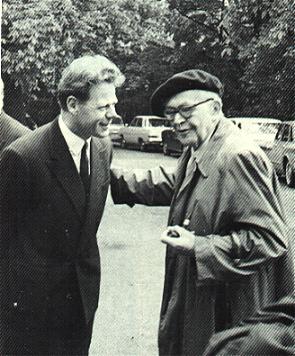The Protestant Church is fractured like a smashed mirror into a myriad of jagged shards, and attempting to put them together results in blood on the hands. Schism is the chronic sin of Evangelicals, resulting in a new schism every time the wind blows and the tragedy may most often be compared to a divorce due to a disagreement over how a tube of toothpaste ought to be squeezed.
Hans Küng may have written the greatest single volume on "The Church." Hans Küng was a key contributor to the Second Vatican Council, and this counsel had made monumental steps towards reconciliation between the Protestant Churches and the Catholic Church. In this book, I found an excellent selection on the horrors of Schism and how Schism should be understood. Is there ever a sin so great that it justifies the dividing of the body of Christ?
If we wish to avoid all these evasions, there is in fact only one alternative: not to look for any theological justifications for the divisions in the Church. We should not justify these divisions, any more than we justify sin, but "suffer" them as a dark enigma, an absurd, ridiculous, tolerable yet intolerable face of life, that is contrary both to the will of God and the good of mankind. And in so far as it is against God's will and man's good, it is at the deepest level failure, guilt, sin--whether of individuals or of the community--and rarely of one "party" alone. However great the misunderstanding, however understandable the historical genesis of the separation and the circumstances of the break, it should never, never among Christians, have come to a division in the Church. A division in the Church is a scandal and a disgrace. Anyone who did not actively try to prevent it, anyone who furthered it in any way at all must bear part of the blame--how much it is not our place to judge. Naturally the mistakes of earlier generations cannot be attributed personally to people alive today. But there is none the less a common responsibility and a common guilt not only for causing but also for perpetuating the division. This guilt weighs heavily upon the separated Churches, just as it does upon divided families who have not been reconciled.
"From her very beginnings there arose in this one and only Church of God certain rifts, which the apostle strongly censures as damnable. But in subsequent centuries more widespread disagreements appeared and quiet large communities became separated from full communion with the Catholic Church--developments for which, at times, men of both sides were to blame. However, one cannot impute the sin of separation to those who at present are born into these communities and are instilled therein with Christ's faith. The Catholic Church accepts them with respect and affection as brothers" (Decretum de Oecumenismo of Vatican II, 3)
The Churches themselves can do nothing to free themselves from guilt in the sight of God, they can only seek to be freed: they are dependent on forgiveness. So the first step in healing the breach must be an admission of guilt and a plea for forgiveness addressed both to God, the Lord of the Church, and to our brothers: "Forgive us our trespasses, as we forgive those who trespass against us." In asking for forgiveness, we ask for the healing of the division and in asking for forgiveness we declare that we are ready to do whatever is God's will to remove the division: Metanoia!
"There can be no ecumenism worthy of the name without a change of heart. For it is from newness of attitudes, from self-denial and unstinted love, that yearnings for unity take their rise and grow towards maturity. We should therefore pray to the divine Spirit for the grace to be genuinely self-denying, humble, gentle in the service of others, and to have an attitude of brotherly generosity towards them. . . . St John has testified: 'If we say that we have not sinned, remake him a liar, and his word is not in us' (1 John 1:10). This holds good for sins against unity. Thus, in humble prayer, we beg pardon of God and of our separated brethren, just as we forgive those who trespass against us. Let all Christ's faithful remember that the more purely they strive to live according to the gospel, the more they are fostering and even practicing Christian unity" (Decretum de Oecumenismo of Vatican II, 7)
Hans Küng, "The Church", pg283-284
As an appendix, I've included the following quotation addressing specifically the statements of reconciliation by Hans Küng in his own words on how the famous phrase "separated brothers and sisters" from Vatican II may be rightly understood.
Although there are still some ambiguities, Vatican II largely clarified the attitude of the Catholic Church to the other Christian Churches.
1. Previously the Catholic Church referred to other Churches only as heretics and schismatics (implying they were not of good faith); now it calls other Christians "separated brethren".
2. Whereas previously it only recognized individual Christians outside the Church, it now recognizes the existence of communities of Christians outside the Catholic Church ("christianae communions", Doe 1).
3. It sees these communities not just as sociological groups, but as "Church communities" or "Churches" ("ecclesiae vel communitates ecclesiasticae", Constitutio de Ecclesia of Vatican II, 15, cf. Decretum de Oecumenismo of Vatican II, 3).
4. It recognizes too the bond existing between these Churches in the ecumenical movement which has arisen outside the Catholic Church and echoes the words of the fundamental declaration of the World Council of Churches: "Everywhere, large numbers have felt the impulse of this grace, and among our separated brethren also there increases from day to day a movement, fostered by the grace of the Holy Spirit, for the restoration of unity among all Christians. Taking part in this movement, which is called ecumenical, are those who invoke the Triune God and confess Jesus as Lord and Saviour. They join in not merely as individuals but also as members of the corporate groups in which they have heard the gospel, and which each regards as his Church and, indeed, God's" (Decretum de Oecumenismo of Vatican II, 1).
5. Thus the Catholic Church does not identify itself exclusively (in spite of some formulas which seem to suggest otherwise) with the Church of Christ. At one point at any rate a striking revision took place: instead of the definitive formula originally suggested by the Commission: "the unique Church of Christ which in the creed we avow as one, holy, catholic, and apostolic . . . is (est) the Catholic Church, which is governed by the successor of Peter and by the bishops in union with that successor", the formulation adopted was: "subsists (substitit) in the Catholic Church (Constitutio de Ecclesia of Vatican II, 8). The reason given by the Commission for this important and unprecedented change in the formula was that "this expression accords better with our recognition of ecclesial communities" mentioned in Constitutio de Ecclesia of Vatican II, 15. The new formulation was purposely as vague as possible, so as not to stand in the way of further theological investigation of this difficult problem, which is certainly necessary.
Hans Küng, "The Church", pg283




Leave a comment